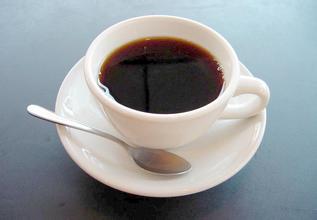How does the coffee taste when it's deep roasted?
The mixing process of basic tastes in deep-roasted coffee is different from that of other coffees. Due to the strong thermal decomposition of coffee beans at high temperatures, most of the sugar in coffee is broken down. Lose sweetness in the sense of taste. Due to the increase of carbolic acid compounds, sweetness is replaced by bitterness.
Bitterness is often misunderstood. The bitterness in food is often regarded as a bad thing. However, in some foods, such as dark chocolate, some beers, red wine and tonic water, bitterness is their hallmark. The characteristic of being popular with people. In all these cases, bitterness contributes a lot to the overall taste, and so does coffee. The acceptability of food and beverages based on bitterness often leads to the most heated controversy. Although deep-roasted coffee plays an important role in the coffee market, its bitterness often affects people's wide acceptance.
(1) there are three sources of bitterness in coffee.
First of all, bitterness is the taste characteristic of certain non-volatile acids, especially chlorogenic acid and quinic acid.
Secondly, the bitter taste is caffeine, N-methyl nicotinic acid internal salt. Coffee beans naturally have the basic flavors of white crystal alkaloids, tea, cocoa beans and cola nuts.
Third, bitterness is related to carbolic acid and heterocyclic compounds. Carbolic acid and heterocyclic compounds are formed during the transition from standard roasted coffee to deep roasted coffee after continuous thermal decomposition of coffee beans at high temperature.
Four combinations are often encountered when tasting deep-baked coffee. Two of these are similar to the combination of standard roasted coffee: acid increases the salty taste of the salt (sharp), and salt reduces the sour taste of the acid (soury). The other two are unique to deep-roasted coffee: bitterness increases the sour taste-bitterness (harsh), and acidity reduces bitterness-irritation (pungent).
(2) the main taste of deep-roasted coffee
To describe the taste of deep-roasted coffee, the first step is to identify its main tastes.
Sharpness: mainly sensed by the front edge of the tongue. The combination of acid and salt in coffee increases the overall salty taste of the drink.
Sour taste: mainly felt by the back edge of the tongue. The combination of salt and acid in coffee reduces the overall sour taste of the drink.
Bitterness: mainly felt at the back of the tongue. The bitter ingredients of coffee combine with acid to increase the overall sour taste of the drink.
Stimulation: mainly sensed by the back of the tongue. The combination of acid and bitterness in the coffee reduces the bitterness of the drink.
The second step is to determine the extent to which a specific taste of coffee matches these tastes. At least there are two main tastes in deep-roasted coffee: irritation and sharpness. These two tastes can be further subdivided into four secondary flavors.
Sharp to salty change-rough (rough)
Sharp change to acid-dry (astringent)
Stimulating the change to acid-- creosote oil flavor (creosoty)
Change from stimulation to bitterness-salty taste (alkaline)
In distinguishing these four flavors, we will encounter a situation unique to deep-roasted coffee:
First, since temperature has little effect on the bitterness and acidity of coffee, the change in temperature will not change the taste of deep-roasted coffee.
Second, many of the fruit acid compounds contained in coffee beans are burned away along with sugar compounds during roasting. So in deep-roasted coffee, sour taste is rarely the main flavor.
Third, when the concentration of bitter ingredients increases, the feeling of bitterness actually weakens. That's why espresso tastes less bitter than the same coffee brewed by traditional methods.

Important Notice :
前街咖啡 FrontStreet Coffee has moved to new addredd:
FrontStreet Coffee Address: 315,Donghua East Road,GuangZhou
Tel:020 38364473
- Prev

Coffee beans taste, taste
1) ahenaste The sensation of steam in brewed coffee, ranging from chocolate to charcoal, from spicy to turpentine. Aftertaste is the smell released by the remaining ingredients in the mouth after swallowing coffee. Aroma The sensation of inhaling the gases released by coffee, ranging from fruity to grassy to nutty. Coffee (Bouquet)
- Next

How does the coffee taste sour and taste?
(1) acidy) the primary taste associated with sweet compounds in coffee. The combination of acid and sugar in the coffee increases the sweetness of the coffee as a whole. Washed Arabica coffee growing above 4000 feet, such as Columbia Premium Coffee, has this characteristic. Sour coffee tastes from spicy (nippy) to spicy (piquant), felt by the tip of the tongue. (2) suffering
Related
- Does Rose Summer choose Blue, Green or Red? Detailed explanation of Rose Summer Coffee plots and Classification in Panamanian Jade Manor
- What is the difference between the origin, producing area, processing plant, cooperative and manor of coffee beans?
- How fine does the espresso powder fit? how to grind the espresso?
- Sca coffee roasting degree color card coffee roasting degree 8 roasting color values what do you mean?
- The practice of lattes: how to make lattes at home
- Introduction to Indonesian Fine Coffee beans-- Java Coffee producing area of Indonesian Arabica Coffee
- How much will the flavor of light and medium roasted rose summer be expressed? What baking level is rose summer suitable for?
- Introduction to the characteristics of washing, sun-drying or wet-planing coffee commonly used in Mantenin, Indonesia
- Price characteristics of Arabica Coffee Bean Starbucks introduction to Manning Coffee Bean Taste producing area Variety Manor
- What is the authentic Yega flavor? What are the flavor characteristics of the really excellent Yejasuffi coffee beans?

